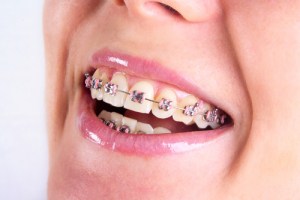There are a number of signs that will help you to know if a relationship with an orthodontist is in your future. In general, any misalignment of the teeth or jaws that keep them from fitting together properly needs attention. You can look at your child’s teeth, and you can watch for telltale behaviors that indicate poor alignment.
Behaviors to Watch For
- Sucking the thumb. While thumb sucking may be normal for very young children, if the behavior continues too long, it can be harmful. The danger is that the front teeth may be pushed out while they are developing, creating a need for corrective work later.
- Breathing through the mouth. This may be a sign that the child’s teeth are overcrowded. If the mouth doesn’t close properly, the child may develop the habit of mouth breathing.
- Biting the cheeks. If your child tends to frequently bite the inside of the lips or cheeks, this is a clear sign that the teeth are not meeting properly. In more severe cases, the lower teeth can even bite into the upper palate.
- Problems biting or chewing. If the teeth do not meet properly in the front, your child may not be able to bite cleanly through food, such as a sandwich. He may have to grip it with his teeth and tear a piece off. Likewise, if the back teeth do not align, he may have to work the food around in his mouth to break it up enough to swallow.
- Grinding the teeth. Your child may grind her teeth across each other or clench them in an attempt to find the place where they fit together. When she closes her mouth naturally, it may not “feel right” because the upper and lower jaws do not properly mesh.
- Speech impairments. Misaligned teeth can cause a variety of problems with speech. One of the most common is a lisp. If your child is exhibiting any difficulties making certain sounds, it may be a sign that an orthodontic device may be needed.
Observable Conditions of the Teeth and Jaws
Besides watching for behavioral signs, you can also look directly at your child’s teeth and see if they appear to be properly aligned. This list gives you a bit of information about the most common conditions that orthodontists treat.
- Underbite. An underbite exists when the front teeth in the lower jaw are forward of the front teeth in the upper jaw when the mouth is closed. Ideally, the upper teeth should be just in front of the lower teeth.
- Overbite. This condition exists when the front teeth in the upper jaw protrude too far in front of the teeth in the lower jaw. The underbite and overbite are the most common malocclusions.
- Crossbite. A crossbite is a situation where the upper teeth are offset toward the center of the mouth. This may affect one or several teeth. If this is difficult to visualize, imagine taking your finger and pushing one of your back teeth in just a bit, enough that it no longer meets the bottom tooth squarely.
- Open bite. If there is an open space between your child’s upper and lower front teeth when the jaws are closed, this is an open bite. In other words, she can stick the tip of her tongue out even with her teeth closed. This condition needs to be treated as soon as you notice it, this is to ensure that it can be properly corrected.
- Crowding. Crowded teeth are very common. Your child may inherit small jaws from one parent and large teeth from the other or the upper jaw from one and the lower jaw from another. Any possible combination can result in “too much tooth” for the size of the jaw.
Includes Other Issues
- Excessive space. This is the opposite of crowding – when there is too much jaw for the size of the teeth. Sometimes all the teeth are small, and sometimes they are the appropriate size, but there are gaps between the teeth.
- Misaligned midlines. Ideally, the line between your child’s two front teeth on the upper jaw should match the line between the two front teeth on the lower jaw. If they are not aligned properly, it can give the face a slightly crooked look.
- Crooked teeth. Many children will have a single tooth that is slanted, crossing in front of or behind another. It is also common for one or more teeth to come in above the others. Both of these conditions can be successfully corrected.
- Protruding or receding jaw. This is a problem with the jaw itself, rather than the teeth. Of course, inherited face shape determines much of the jawline, but sometimes there is a growth disorder that causes abnormal development. Early intervention with an orthodontic device can influence the growth of the jaw and prevent a deformity.
- Popping or cracking from the jaw. Any noise or pain that comes from the jaw joint when your child is eating or talking is a sign that the jaws are misaligned. This condition requires treatment to keep it from becoming a progressive disorder.
Advantages of Expert Orthodontic Treatment
You are most likely to notice a malocclusion of your child’s teeth or jaws when he is between the ages of 6 and 12. These conditions are not likely to get better on their own, but they can all be corrected with expert treatment. Orthodontic braces can ensure that your child will not suffer any lasting effects of misaligned teeth. These include:
– Abnormal wear. Wherever the teeth do not meet squarely, they are subject to excessive wear. This can destroy the enamel on the surface of the tooth and eventually change the shape of the tooth as it wears away.
– A “gummy” smile. This situation, where the smile shows too much of the upper gums, is often the result of an uncorrected overbite.
– Lips that protrude. When the teeth protrude, they naturally push the lips out, too. This can produce a profile where the lips appear to be too far forward relative to the nose and chin.
– Tooth decay. When the teeth are crowded or overlap, it is much more difficult to properly brush and floss. This can lead to decay, cavities, gum disease and expensive, uncomfortable repairs.
– Poor self-esteem. Having an unattractive smile can cause your child to feel insecure and even avoid smiling. This can have a devastating effect on your child’s social development, especially during the pre-teen and teen years. While you can’t fix every hurt your children will feel during this time of life, expert treatment can give them a great smile.
We’re Here To Help
If you think your child may need braces, contact us at our Spartanburg, South Carolina, office. An orthodontist can evaluate your child and let you know if we recommend treatment. Healthy teeth and a beautiful smile are always in fashion.
Nease and Higginbotham Orthodontics
424 Hyatt Street – Suite E
Gaffney
SC 29341
Phone: (864) 579-7700
Do You need Braces? [An Expert Opinion]


